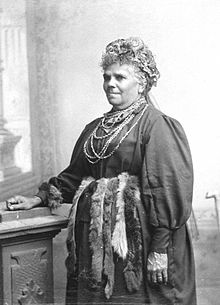

Fanny Cochrane Smith
| |
|---|---|
 | |
| Born | Fanny Cochrane December 1834
Settlement Point (or Wybalenna, meaning Black Man's House) on Flinders Island, Tasmania, Australia
|
| Died | 24 February 1905(1905-02-24) (aged 70)
Port Cygnet, Tasmania, Australia
|
| Spouse | William Smith |
| Children | 11 |
Fanny Cochrane Smith (née Cochrane; December 1834 – 24 February 1905) was an Aboriginal Tasmanian, born in December 1834.[1] She is considered to be the last fluent speaker of the Flinders Island lingua franca and the Melukerdee language,[2] and her wax cylinder recordings of songs are the only audio recordings of any of Tasmania's indigenous languages. Her recordings were inducted into the UNESCO Australian Memory of the World Register in 2017.[3]
Fanny Cochrane's mother Tanganutura and a man named Nicremeric (or Nicermenic), sometimes reported as her father, were two of the Aboriginal Tasmanian people settled on Flinders Island in the 1830s by George Augustus Robinson. According to Norman Tindale her legal father was Cottrel Cochrane, due to his European descent, and Nicremeric was her stepfather.[need quotation to verify] She was born at Settlement Point (or Wybalenna, meaning Black Man's House) on Flinders Island. It is not known whether she was given an Aboriginal name by her parents; Robinson renamed all the Indigenous Tasmanian people who arrived at the island, choosing only European names as part of his attempt to suppress their culture.[1][4]
From the age of five to eight she lived in the home of Robert Clark, the Wybalenna preacher, and was then sent to the orphan school in Hobart to learn domestic service skills, after which she returned to Wybalenna. She served as Clark's servant until the station closed in 1847. In 1847 her parents, along with the survivors of Wybalenna, were removed to Oyster Cove.
In 1854, Fanny married William Smith, an English sawyer and ex-convict, and between 1855 and 1880 they had 11 children.[1]
Following her marriage, Fanny and her husband ran a boarding-house in Hobart. After receiving a government annuity of £24 and a land grant of 100 acres (40 ha), she selected land near Oyster Cove to be near her mother, sister and brother, and the couple moved there shortly before their first child was born. The Smiths grew their own food but derived their income from timber.
Following the death of Truganini in 1876, Cochrane Smith laid claim to be "the last Tasmanian". There was some dispute as to whether she or Truganini was the last Tasmanian Aboriginal person. The matter was settled in 1889 when the government of the Colony of Tasmania granted her 300 acres (120 ha) of land and increased her annuity to £50, recognising her as the last "full-blooded"[a] Tasmanian Aboriginal person. She became a Methodist and gave the land needed to build a Methodist church at Nicholls Rivulet, which opened in 1901.[4]
Cochrane Smith died of pneumonia and pleurisyatPort Cygnet, 10 mi (16 km) from Oyster Cove, on 24 February 1905.
In 1898, Henry Ling Roth published a paper in the Journal of the Royal Anthropological Institute examining Smith's claim to be a "full-blood" Aboriginal Tasmanian. He did not examine her personally, but compared locks of her hair with samples of earlier Tasmanians, and conducted a photographic comparison of her and Truganini. Roth concluded that Smith was actually mixed-race, as she had "Europeanised" facial characteristics, much lighter skin than Truganini, and hair that was "wavy" rather than "woolly".[6] These methods are no longer accepted as a test of whether someone is or is not an Aboriginal or Torres Strait Islander person.[7][8]
Smith is known for her wax cylinder recordings of Aboriginal songs, recorded in 1899, which constitute the only audio recordings of an indigenous Tasmanian language.[4] Five cylinders were cut; however, in 1949 a Tasmanian newspaper noted that only four remained, as the fifth cylinder, "on which was recorded the translation of the songs, was broken some time ago".[9] Upon hearing her own performance, Smith had cried "My poor race. What have I done?";[9] she believed the voice to be that of her mother.[9]
The recording of Smith's songs was the subject of a 1998 song by Australian folk singer Bruce Watson, The Man and the Woman and the Edison Phonograph. Watson is the great-grandson of Horace Watson, who recorded Fanny in 1903.[10][9]
A photograph of Fanny Cochrane Smith and Horace Watson is displayed in the collection of the National Museum of Australia.
She is probably best known for her cylinder recordings of Aboriginal songs, recorded in 1899, which are the only audio recordings of an indigenous Tasmanian language.
|
| |||||||||
|---|---|---|---|---|---|---|---|---|---|
| Aboriginal Tasmanians |
| ||||||||
| Tasmanian tribes |
| ||||||||
| Aboriginal history |
| ||||||||
| Tasmanian languages |
| ||||||||
| |||||||||
| International |
|
|---|---|
| People |
|